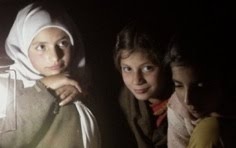
This year I received one of the most intriguing Christmas gifts ever. In a wooden box labeled “Gifts of The Wise Men”, are three smaller metallic ones. One contains a tiny amount of ‘edible gold dust’, another has several small frankincense incense cones, and a myrrh-scented balm occupies the third!
My mind goes to those Sunday School Christmas plays of many years ago. With my short hair, and being one of the taller children, I was invariably cast as one of the Three Kings. In a robe created from an old silk sari, a gold-foil crown, clutching a velvet pouch, or ceramic jars that had to pass off as gifts of gold, frankincense or myrrh – I was strangely filled with the importance and significance of the moment. I recall the Three Kings making an entrance in measured in measured steps as the choir belted out: “We three kings of Orient are/ Bearing gifts, we traverse so far ….”
A brief narration, mentioned only in one of the four Biblical gospels, that of Matthew, to me this story of the visit of the Wise Men is the most evocative of the stories surrounding the birth of Jesus. We are told that the Wise Men came from the East, read the night sky, and carried gifts to a child whose star they had observed and followed.
Many add-on legends have grown up around them, introducing features like they were three in number, that they were kings, that they arrived on camels.
The tradition of Los Tres Reyes Magos The Three Wise Kings, in Puerto Rico is taken very seriously. The Catholic Church declared the Magi as Saints, giving each his own Day of Feast.
El Rey Gaspar was Emperor of the Orient and ruled over all oriental lands. He is also represented as white but does not wear a beard. His clothes were gilded in gold. Gaspar's gift was frankincense, an aromatic oil that symbolized prayer. Frankencense was priceless and a gift for Kings. Gaspar is said to have also brought many other fine gifts for the Christ Child. It is said that Gaspar traveled the furthest to visit the Christ Child. Saint Gaspar's feast day is January 6th.
El Rey Melchor was a Nubian King and ruler of Ethiopia. Melchor was dressed in exquisite robes. His gift was myrrh, an aromatic resin that comes from the bark of thorny African trees and symbolized suffering. Myrrh was a precious comodity in the Middle East. He is also rumored to have brought many other expensive gifts and treasures along. Saint Melchor's feast day is January 7th.
El Rey Baltazar was the Sultan of Arabia. He was the oldest of the Magi and was a small and gentle man. Baltazar had a long white beard and wore elegant crimson robes. His gift was gold but he is rumored to have brought many other priceless gifts as well. Legend tells us that Baltazar died soon after in the presence of the other Wise Men. His figure traditionally goes before the others on a manger scene. Saint Baltazar's feast day is January 8th.
But ... they are not referred to as kings in the Bible. Though the Revised Standard Version translates the Greek as ‘wise men’, the word is ‘magi’ – it is in the plural, yes, but we don't know exactly how many.
The term ‘magi’ has several distinct connotations. It can designate a Persian priestly caste called the Magians, through most scholars favor the meaning ‘astrologers’, as it was their observation of the stars that prompted their journey.
Matthew tells us that the visitors celebrated the Christ child with the most valuable items in the ancient world: gold, frankincense and myrrh.
Much has been speculated about the meaning and relevance of these gifts. In Jesus’ time, they were all expensive and precious, though widely used, as frankincense and myrrh were known to be powerful medicines. Frankincense comes from trees and myrrh from bushes that grow along southern Arabia and Somalia. When an incision is made in their trunks or stems, sap oozes out, congealing with exposure to air. This is gathered and sold ounce by precious ounce.
But it is the symbolic nature of these three gifts, as they foretell events of the Baby Jesus’ life that are of real meaning.
The wider consensus is that gold is symbolic of royalty, of kingship; the baby will be king, but a king in God’s terms, not ours.
Frankincense burns with a white, fragrant smoke and was thought to carry prayers to heaven. Used commonly in ritual worship, it was perhaps symbolic of Jesus’ priestly, teaching role, or a sign that Jesus himself would be worshipped by so many.
Myrrh was used for anointing a body before burial, so already Matthew sets before us a portent of things to come: the fact that death and grief are part of Jesus’ story, just as they are so very much part of our own.
The three gifts contain within them a Story of the holy and exemplary life of a great teacher, Jesus, that will unfold to challenge hypocritical observances, to engage in radical compassion, to teach through example the power of true loving and forgiving.
Each year, we hope the Story of the Gifts will remind us to follow on this path.
Marguerite Theophil
Stories are, quite simply, our native language.
~ Bill Mooney
